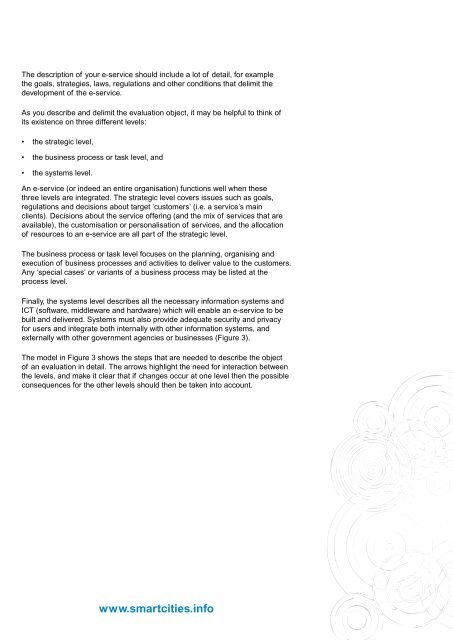Evaluating the impact of local e-services - Smart Cities
Evaluating the impact of local e-services - Smart Cities
Evaluating the impact of local e-services - Smart Cities
You also want an ePaper? Increase the reach of your titles
YUMPU automatically turns print PDFs into web optimized ePapers that Google loves.
The description <strong>of</strong> your e-service should include a lot <strong>of</strong> detail, for example<br />
<strong>the</strong> goals, strategies, laws, regulations and o<strong>the</strong>r conditions that delimit <strong>the</strong><br />
development <strong>of</strong> <strong>the</strong> e-service.<br />
As you describe and delimit <strong>the</strong> evaluation object, it may be helpful to think <strong>of</strong><br />
its existence on three different levels:<br />
• <strong>the</strong> strategic level,<br />
• <strong>the</strong> business process or task level, and<br />
• <strong>the</strong> systems level.<br />
An e-service (or indeed an entire organisation) functions well when <strong>the</strong>se<br />
three levels are integrated. The strategic level covers issues such as goals,<br />
regulations and decisions about target ‘customers’ (i.e. a service’s main<br />
clients). Decisions about <strong>the</strong> service <strong>of</strong>fering (and <strong>the</strong> mix <strong>of</strong> <strong>services</strong> that are<br />
available), <strong>the</strong> customisation or personalisation <strong>of</strong> <strong>services</strong>, and <strong>the</strong> allocation<br />
<strong>of</strong> resources to an e-service are all part <strong>of</strong> <strong>the</strong> strategic level.<br />
The business process or task level focuses on <strong>the</strong> planning, organising and<br />
execution <strong>of</strong> business processes and activities to deliver value to <strong>the</strong> customers.<br />
Any ‘special cases’ or variants <strong>of</strong> a business process may be listed at <strong>the</strong><br />
process level.<br />
Finally, <strong>the</strong> systems level describes all <strong>the</strong> necessary information systems and<br />
ICT (s<strong>of</strong>tware, middleware and hardware) which will enable an e-service to be<br />
built and delivered. Systems must also provide adequate security and privacy<br />
for users and integrate both internally with o<strong>the</strong>r information systems, and<br />
externally with o<strong>the</strong>r government agencies or businesses (Figure 3).<br />
The model in Figure 3 shows <strong>the</strong> steps that are needed to describe <strong>the</strong> object<br />
<strong>of</strong> an evaluation in detail. The arrows highlight <strong>the</strong> need for interaction between<br />
<strong>the</strong> levels, and make it clear that if changes occur at one level <strong>the</strong>n <strong>the</strong> possible<br />
consequences for <strong>the</strong> o<strong>the</strong>r levels should <strong>the</strong>n be taken into account.<br />
www.smartcities.info



